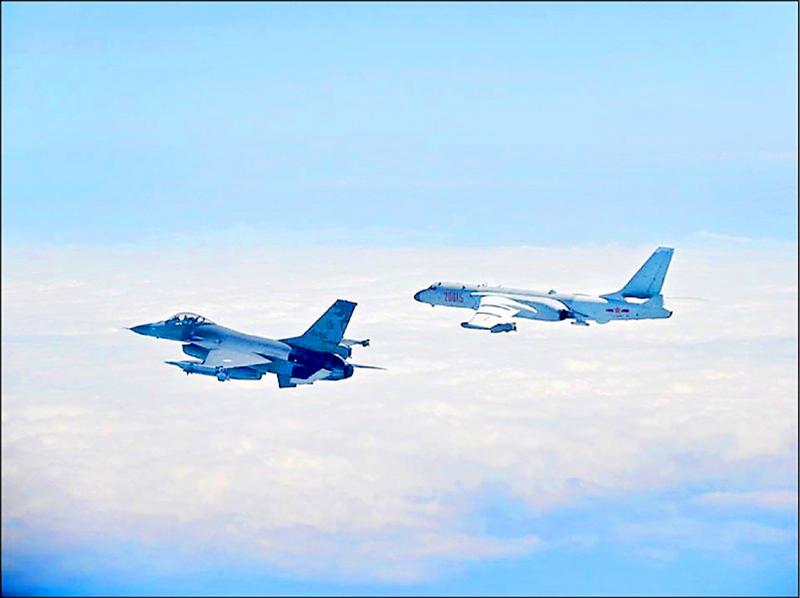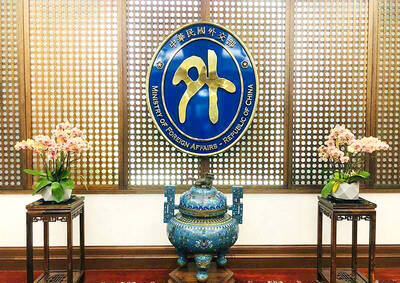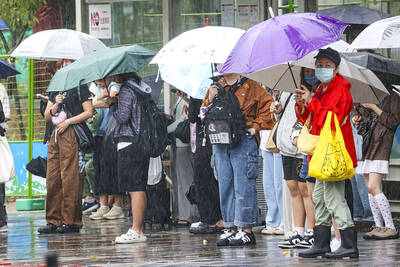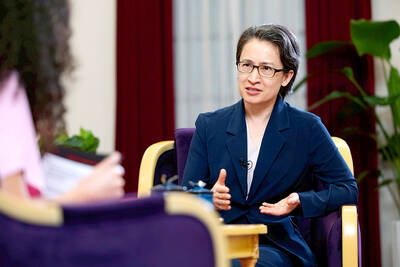The military must adjust its strategies as the methods of the Chinese People’s Liberation Army (PLA) Air Force undergo a qualitative shift, retired Republic of China Air Force deputy commander Chang Yen-ting (張延廷) said on Saturday.
Over the past few months, there have been frequent sightings of Chinese military aircraft near Taiwan and Ministry of National Defense data shows that an incursion on Aug. 10 was the third time since March last year that PLA aircraft had crossed the median line of the Taiwan Strait.
Military tensions between China and the US in the Strait and the South and East China seas are continuing to escalate, while tensions between Taiwan and China have become a norm, Chang said, adding that both situations increase the likelihood of triggering a flashpoint in the region.

Photo courtesy of Ministry of National Defense
The Taiwanese military considers the air space encompassing the 12 nautical miles (22.2km) from the coast of Taiwan to the median line as the “inception zone,” where it monitors aircraft, broadcasts messages to chase any that enter out and can order surface-to-air missile units to be placed on standby if needed, Chang said.
However, the emergency scrambling of Taiwanese fighters is starting to have an effect on equipment maintenance and pilot fatigue, and the military must make adjustments to its standing systems, he added.
“We cannot be led about by the nose by the enemy,” Chang said.
One of the China’s common methods to test Taiwanese reaction speed and capability is to perform military exercises west of the median line before sending aircraft across it, he said.
“We must take notice and come up with a way to react and counter their probing efforts,” he said.
Should the international community become used to China’s attempt to show its sovereignty over the region, it could become easy for them to misperceive the Strait and nearby area as Chinese territory, he said.
The military must prevent China from using its strategies of unrestricted warfare, or precision or decapitation strikes, in or near the Strait, Chang said.
The air force has many weaknesses it must address, he said, citing its mainstay fighters, which are parked in open hangars.
“The forces committed to the defense of airfields is spread too thin over a wide area,” he said, adding that compared to Israel, Taiwan’s airfields are lightly guarded.
If China were to target the eight main strategic airfields with fast-strike units, such as people on motorcycles with grenades at times when defense is lax, it would be easy to wipe out Taiwan’s main combat jets, Chang said.
Without air superiority, Taiwan would be forced to cede the skies to China, which would spell a different outcome should hostilities across the Strait resume, he said.
Chang’s comments follow media reports that cited a former military instructor, who was not named, as saying that should Taiwan lose air superiority, the nation’s defenses would not last 48 hours.
The Air Force Command Headquarters on Saturday said that anti-air units are deployed near strategic targets and it has stepped up anti-air defense capabilities.
It said that Taiwanese can rest assured, as the air force has contingency plans to allow it to “swiftly recuperate and regain combat capabilities” should airfields be damaged.

Temperatures in northern Taiwan are forecast to reach as high as 30°C today, as an ongoing northeasterly seasonal wind system weakens, the Central Weather Administration (CWA) said. CWA forecaster Tseng Chao-cheng (曾昭誠) said yesterday that with the seasonal wind system weakening, warmer easterly winds would boost the temperature today. Daytime temperatures in northern Taiwan and Yilan County are expected to range from 28°C to 30°C today, up about 3°C from yesterday, Tseng said. According to the CWA, temperature highs in central and southern Taiwan could stay stable. However, the weather is expected to turn cooler starting tonight as the northeasterly wind system strengthens again

The Ministry of Foreign Affairs (MOFA) yesterday expressed “grave concerns” after Singaporean Prime Minister Lawrence Wong (黃循財) reiterated the city-state’s opposition to “Taiwanese independence” during a meeting with Chinese Premier Li Qiang (李強). In Singapore on Saturday, Wong and Li discussed cross-strait developments, the Singaporean Ministry of Foreign Affairs said in a statement. “Prime Minister Wong reiterated that Singapore has a clear and consistent ‘one China’ policy and is opposed to Taiwan independence,” it said. MOFA responded that it is an objective fact and a common understanding shared by many that the Republic of China (ROC) is an independent, sovereign nation, with world-leading

COOLING OFF: Temperatures are expected to fall to lows of about 20°C on Sunday and possibly 18°C to 19°C next week, following a wave of northeasterly winds on Friday The Central Weather Administration (CWA) on Sunday forecast more rain and cooler temperatures for northern Taiwan this week, with the mercury dropping to lows of 18°C, as another wave of northeasterly winds sweeps across the country. The current northeasterly winds would continue to affect Taiwan through today, with precipitation peaking today, bringing increased rainfall to windward areas, CWA forecaster Liu Pei-teng (劉沛滕) said. The weather system would weaken slightly tomorrow before another, stronger wave arrives on Friday, lasting into next week, Liu said. From yesterday to today, northern Taiwan can expect cool, wet weather, with lows of 22°C to 23°C in most areas,

DEFENDING FREEDOM: Taiwanese love peace and helping others, and hope to be a positive force in the world, Vice President Hsiao Bi-khim told ‘Weltspiegel’ Taiwan is making every effort to prevent war in the face of China’s hybrid coercion tactics and military threats, Vice President Hsiao Bi-khim (蕭美琴) said in an interview with German public broadcaster ARD’s program Weltspiegel that aired on Monday. Taiwan is not seeking provocation or intending to disrupt international order, but “must possess the capacity for self-defense,” a news release issued by the Presidential Office yesterday quoted her as saying. Taiwan is closely watching not only the increasing scope and frequency of Chinese military exercises around the nation, but also Beijing’s hybrid and cognitive warfare tactics, including manipulating public opinion, fostering